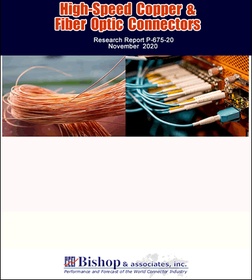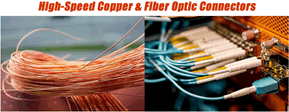High-Speed Copper & Fiber Optic Connectors
| Report Number: P-675-20 |
Price:
$5135.00
|
| Publication Date: November 2020 |

This is invisible
High-Speed Copper & Fiber Optic Connectors
- What technical and economic factors may be changing the copper vs. fiber selection process? What may be the practical bandwidth limit of a copper interface? What are the primary advantages of fiber optic communication links?
- In what applications do mid-board optical transceivers make sense? What is driving interest in “jump-over” cable technology? What advantages do co-packaged optics bring to system design? Are co-packaged optics an interim step toward optical computing?
- What are the distance limitations (reach) of high-speed copper channels? How is the performance of high-speed copper interconnects quantified? Are there any new technologies that will significantly improve the performance of copper cable assemblies?
- What standard writing organizations are actively developing the specifications that define the performance of high-speed copper and fiber optic links?
- What applications will continue to drive exponential demand for data center capacity and speed? Are active optical cables a long-term solution or a transitional tool between copper and fiber networks? How does thermal management issues impact I/O connector selection?
- What is the current market for medium to short-length high-speed copper cable assemblies? What is the five-year world forecast by region for these assemblies? What is the current market and five-year world forecast for high-speed fiber optic interconnects?
Bishop & Associates research report, High-Speed Copper & Fiber Optic Connectors explores these issues and others. This report offers a snapshot of fiber optic and high-speed copper connector technology and markets as it exists in the fall of 2020, and defines what may be the first steps of a major evolutionary change in the market for this class of interfaces. Be prepared for this change. Order your copy of High-Speed Copper & Fiber Optic Connectors.
This is invisible
High-Speed Copper & Fiber Optic Connectors
Table of Contents
Chapter 1 – Report Scope and Methodology
- Report Objectives
- Report Issues Explored
- Methodology and Approach
Chapter 2 – Executive Summary
- Global Average IP Taffic Per Device
Chapter 3 – Introduction
- Introduction
- Copper Interconnect Technology
- Optical Interconnect Technology
- Basic Principals of Optical Transmission
- Optical Fiber Types
- Fiber Types and Typical Specifications
- Fiber Optic Connector Loss Characteristics
- Optical Connector Types
- Copper Connector Termination Process
- Optic Connector Termination Process
Chapter 4 – Evolution of High-Speed Copper Interconnects
- Extending the Bandwidth of Copper
- Advanced Signal Conditioning
- High-Speed Signal Measurement and Verification
- Advanced Signal Modulation Techniques
- Evolving High Performance Connector Trends
Chapter 5 – Evolution of Fiber Optic Connectors
- Fiber Optic Connector Basics
- Single Fiber Connectors
- Multi-Fiber Connectors
- Fiber Optic Adapters, Special Purpose Interfaces
- Optical Backplane Connectors
- Ruggidized Optical Connectors
Chapter 6 – Small Form Factor Pluggable Transceivers
- Why Pluggables?
- Thermal Management
Chapter 7 – Active Optical Cables
- Filling the Gap
- AOC Construction/Features
- AOC Applications
- Representative AOC Manufacturers and Products
Chapter 8 – The Case for Optical Components Inside the Box
- Hitting the Limits of Copper
- Copper Jump-Over Cable Assemblies
- Optical On-Board Mounted Transceivers and Cable Assemblies
- Benefits and Tradeoffs of On-board Optics
Chapter 9 – Optic Interconnect Industry Standards
- Evolving Standards
- FOCIS Standards
- TIA / EIA / IEC Standards
- SONET
- Ethernet
- OIF Implementation Agreements
- COBO
Chapter 10 – Making the Copper or Fiber Decision
- Factors and Choices
- Balancing Feature and Requirements
Chapter 11 – Advanced Copper and Optical Fiber Technology
- Advanced Copper Transmission Technology
- Advanced Fiber Optic Transmission Technology
- Silicon Photonics
- Co-Packaged Optics
Chapter 12 – Alternative Technologies
- Wireless Transmission
- Low-Power/Short Range RF Data Links
- Cellular Telephony
- Wi-Fi
- Millimeter Wave Interconnect Technology
- Plastic mm Waveguide
Chapter 13 – Emerging Copper and Fiber Applications
- Introduction
- 5G Cellular Communications
- Internet of Things (IoT)/Industrial Internet of Things (Industry 4.0)
- Hyperscale Data Centers/Cloud Computing/Disaggregated Data Centers
- Autonomous Transportation
- Artificial Intelligence
- Advanced Military Electronics
Chapter 14 – Copper and Fiber Market Estimates and Forecast
- Introduction
- World Fiber Optic Cable Terminated Connector Market by Region 2019-2020
- World Fiber Optic Cable Terminated Connector Market by Region 2020-2021
- World High-Speed Copper Cable Terminated Connector Market by Region 2019-2020
- World High-Speed Copper Cable Terminated Connector Market by Region 2020-2021
- World Fiber Optic Cable Terminated Connector Market, Telecom/Datacom Applications by Region 2019-2020
- World Fiber Optic Cable Terminated Connector Market, Telecom/Datacom Applications by Region 2020-2021
- World High-Speed Copper Cable Terminated Connector Market, Telecom/Datacom Applications by Region 2019-2020
- World High-Speed Copper Cable Terminated Connector Market, Telecom/Datacom Applications by Region 2020-2021
- World Fiber Optic Cable Terminated Connector Market, Computing Applications by Region 2019-2020
- World Fiber Optic Cable Terminated Connector Market, Computing Applications by Region 2020-2021
- World High-Speed Copper Cable Terminated Connector Market, Computing Applications by Region 2019-2020
- World High-Speed Copper Cable Terminated Connector Market, Computing Applications by Region 2020-2021
- World Fiber Optic Cable Assembly Market, Telecom/Datacom Applications by Region 2019-2020F
- World Fiber Optic Cable Assembly Market, Telecom/Datacom Applications by Region 2020F-2021F
- World High-Speed Copper Cable Assembly Market, Telecom/Datacom Applications by Region 2019-2020F
- World High-Speed Copper Cable Assembly Market, Telecom/Datacom Applications by Region 2020F-2021F
- World Fiber Optic Cable Assembly Market, Computing Applications by Region 2019-2020F
- World Fiber Optic Cable Assembly Market, Computing Applications by Region 2020F-2021F
- World High-Speed Copper Cable Assembly Market, Computing Applications by Region 2019-2020F
- World High-Speed Copper Cable Assembly Market, Computing Applications by Region 2020F-2021F
- World Fiber Optic Connector Forecast, Telecom/Datacom Applications by Region 2020F-2025F
- World High-Speed Copper Connector Forecast, Telecom/Datacom Applications by Region 2020F-2025F
- World Fiber Optic Connector Forecast, Computing Applications by Region 2020F-2025F
- World High-Speed Copper Connector Forecast, Computing Applications by Region 2020F-2025F
- World Fiber Optic Cable Assembly Forecast, Telecom/Datacom Applications by Region 2020F-202F
- World Fiber Optic Cable Assembly Forecast, Computing Applications by Region 2020F-2025F
- World High-Speed Copper Cable Assembly Forecast, Telecom/Datacom Applications by Region 2020F-2025F
- World High-Speed Copper Cable Assembly Forecast, Computing Applications by Region 2020F-2025F
Chapter 15 – Major Findings and Conclusions
This is invisible
High-Speed Copper & Fiber Optic Connectors

Bishop & Associates released this 15-chapter, 234-page research report that examines high-speed copper & fiber optic connectors. High-Speed Copper & Fiber Optic Connectors, reviews how high-speed copper and fiber optic connectors are continuing to evolve to support the ever-increasing demand for higher bandwidth, signal integrity, increased panel density, and reduced power. Current, state of the art copper printed circuit board interfaces continue to exceed perceived performance limitations through a combination of fine tuning of the internal signal path, optimized PCB launch, advanced signal conditioning, and adoption of PAM4 modulation. High-performance shielded differential pair cables can significantly increase the reach of high-speed signals.
Design engineers are beginning to find applications that require performance beyond the practical limits of copper. In addition to inherent bandwidth size and weight advantages, newer fiber optic connectors are becoming smaller, easier to terminate, less susceptible to contamination and capable of terminating many single mode fibers simultaneously. In the past, fiber was limited to long-reach applications that were measured in kilometers. Advanced optical signaling technology including coherent signaling can greatly increase the data capacity of a single fiber. Today, fiber links are being considered for rack-to-rack, server to top of rack, and even select inside the box applications. Attenuation and signal degradation attributed to PCB laminates is stimulating the growth of both copper and fiber optic links that lift high-speed signals out of the board entirely.
This report focuses primarily on telecom and computing applications with some additional discussion in related consumer and military/aerospace applications. The basic characteristics of high-speed copper and fiber optic connectors are reviewed, as well as advanced silicon photonic transceiver technology. Also discussed are high-speed copper cable assemblies both passive and those with active equalization features, which enable greater bandwidth and length.
Additional chapters discuss the evolution of small form factor pluggable interfaces that provide options for both copper and fiber links. The advantages and typical applications of active optical cables are also reviewed.
One chapter is focused on the role of formal and industry sponsored standards that facilitate the implementation and certification of both copper and fiber optic links.
Another chapter identifies a series of applications that are driving the development of high-speed communications and represent long-term growth for both copper and fiber optic connectors.
The report also reviews the many alternative wireless technologies that are available to address high-speed link applications. Emerging millimeter band communication including 5G are reviewed.
Mid-board optical transceivers and co-packaged optics are emerging technologies that provide packaging solutions for high-performance circuits. Both topics are discussed along with their potential long-term impact on system design.
Download a descriptive brochure here



